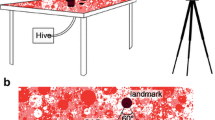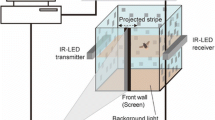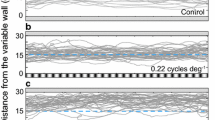Summary
-
1.
In the stingless bee, Trigona (Tetragonisca) angustula, hovering guard bees keep their position relative to a moving stripe pattern mounted on the front face of the nest box constant by flying forwards and backwards parallel to the pattern movement (Fig. 2).
-
2.
The response is guided by two cues: (1) image position and motion of the pattern and (2) the retinal position of the nest entrance (Figs. 2–5).
-
3.
Guard bees react to an expanding and contracting pattern by moving away from and towards the nest box (Figs. 6, 7). Bees always fly away from an expanding pattern in a direction that is defined by a line connecting the centre of expansion with the bee's position at the time the movement starts (Fig. 8).
-
4.
A procedure based on Collett's 2nd optomotor rule can explain the ability of the bees to determine visually the direction of compensatory thrust (Fig. 10). The procedure is robust in 3 respects: (1) there will be no thrust generated in response to animal rotations as long as a scene contains contrast elements throughout the visual field; (2) errors in the direction of compensatory thrust are small even if the local direction of image motion alone is taken into account and not its magnitude; (3) only very few pattern elements are needed for the procedure to work.
Similar content being viewed by others
References
Borst A, Egelhaaf M (1989) Principles of visual motion detection. Trends Neurosci 12:297–306
Cartwright BA, Collett TS (1983) Landmark learning in bees. J Comp Physiol 151:521–543
Cartwright BA, Collett TS (1987) Landmark maps for honeybees. Biol Cybern 57:85–93
Collett TS (1980) Some operating rules for the optomotor system of a hoverfly during voluntary flight. J Comp Physiol 138:271–282
Collett TS, Land MF (1975) Visual spatial memory in a hoverfly. J Comp Physiol 100:59–84
Reichardt W, Schlögl R (1988) A two dimensional field theory for motion computation. Biol Cybern 60:23–35
Reichardt W, Egelhaaf M, Schlögl RW (1988) Movement detectors provide sufficient information for local computation of 2-D velocity field. Naturwissenschaften 75:313–315
van Hateren JH (1990) Directional tuning curves, elementary movement detectors, and the estimation of the direction of visual movement. Vision Res (in press)
Warren WH, Hannon DJ (1990) Eye movements and optical flow. J Opt Soc Am A7:160–169
Wehner R (1981) Spatial vision in arthropods. In: Autrum H (ed) Handbook of sensory physiology, vol VII/6C. Springer, Berlin Heidelberg New York, pp 287–617
Wittmann D (1985) Aerial defense of the nest by workers of the stingless bee Trigona (Tetragonisca) angustula (Latreille) (Hymenoptera: Apidae). Behav Ecol Sociobiol 16:111–114
Wittmann D, Radtke R, Zeil J, Lübke G, Francke W (1990) Robber bees (Lestrimelitta limao) and their host: chemical and visual cues in nest defense by Trigona (Tetragonisca) angustula (Apidae: Meloponinae). J Chem Ecol 16:631–641
Zanker J (1990) On the directional sensitivity of motion detectors. Biol Cybern 62:177–183
Zeil J, Wittmann D (1989) Visually controlled station-keeping by hovering guard bees of Trigona (Tetragonisca) angustula (Apidae: Meliponinae). J Comp Physiol A 165:711–718
Author information
Authors and Affiliations
Rights and permissions
About this article
Cite this article
Kelber, A., Zeil, J. A robust procedure for visual stabilisation of hovering flight position in guard bees of Trigona (Tetragonisca) angustula (Apidae, Meliponinae). J Comp Physiol A 167, 569–577 (1990). https://doi.org/10.1007/BF00190828
Accepted:
Issue Date:
DOI: https://doi.org/10.1007/BF00190828




